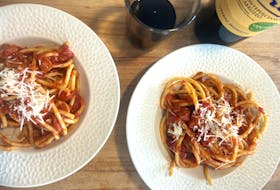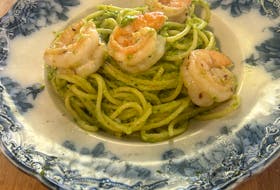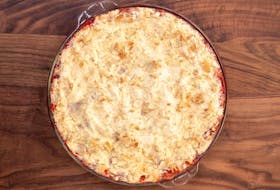Our cookbook of the week is Japanese Home Cooking by teacher, noodle maker and grain activist Sonoko Sakai. Tomorrow, we’ll feature an interview with the author.
To try another recipe from the book, check out: Chilled soba noodles with walnut dipping sauce , and okonomiyaki (“as you like it”) pancakes with bonito flakes .
Just as popular as ramen, curry and rice is on the table at least once a week in Japan, says Sonoko Sakai. And while the vast majority of cooks relies on store-bought curry bricks, she took a different approach in Japanese Home Cooking by crafting the roux from scratch.
“Everybody eats curry and it’s the most comforting Japanese home-cooked food, but all the cooks and the chefs depend on the industrial brick,” says Sakai. “It’s almost like it’s become part of the culture to use that.”
Sakai started making her own curry bricks when she noticed that unsustainable palm oil was the first ingredient listed on packaged versions. “I didn’t want to feed that to my family anymore and I didn’t want that to be part of my book, even though I needed to figure out a way to introduce Japanese curry because it’s different from Indian dishes,” she adds.
The resulting recipe — a warming, mild blend of black mustard seeds, cinnamon, cardamom, coriander and a generous handful of other spices — can be adapted to your tastes (for spicier curry, simply add more cayenne pepper) and will keep for one week in the fridge, or three months in the freezer.
With some planning, homemade Japanese curry can easily be within your reach on a weeknight, something Sakai was happy to discover was of interest to many people. “It’s just been the most fun experience about writing this book,” she says, “because I have a completely new audience that wants to learn how to make these homemade curry bricks.”
JAPANESE CHICKEN CURRY WITH RELISH OF THE SEVEN LUCKY GODS
2 tbsp vegetable oil
1 1/2 lb (680 g) boneless, skinless chicken thighs, cut into 1-inch (2.5 cm) chunks
2 onions, halved and thinly sliced
2 cloves garlic, minced
2 tbsp minced ginger
2 carrots, cut into bite-size pieces
1 celery stalk, cut into bite-size pieces
1 lb (455 g) Yukon Gold, russet, or other potatoes, peeled and cut into bite-size pieces
4 cups (960 mL) Bonito and Kombu Dashi (recipe follows) or chicken stock
1 tbsp honey
2 tbsp soy sauce, or to taste
2 tbsp sake
1/3 recipe Japanese Curry Brick (recipe follows)
Salt and freshly ground black pepper
1 recipe Fukujinzuke (recipe follows)
Step 1
Heat the oil in a large saucepan over medium heat. Add the chicken and cook until lightly browned, 6 to 8 minutes.
Step 2
Reduce the heat to low and add the onions, garlic and ginger. Cook until softened, about 5 minutes. Add the carrots, celery, potatoes, dashi, honey, soy sauce and sake, increase the heat to medium-high and bring to a boil. Lower the heat and simmer for 20 minutes, or until the liquid is reduced by a third. Add the curry brick, stir to break it down, and continue simmering until the sauce is thickened but still pourable and reduced by about two-thirds, about 30 minutes. Season with salt and pepper as needed. Remove from heat and serve with rice and fukujinzuke.
Makes: 4 servings
BONITO AND KOMBU DASHI
5 cups (1.2 L) filtered water
1 piece kombu, about 3 x 3 inches (7.5 x 7.5 cm)
4 cups (30 g) bonito flakes
Step 1
Combine the water and kombu in a medium saucepan. Heat over low heat until bubbles begin to form around the kombu, 5 to 10 minutes. Remove the piece of kombu before the water comes to a boil. Bring the water to a boil, turn off the heat. Add the bonito flakes. Let stand for 2 minutes, without stirring, to steep the bonito flakes.
Step 2
To strain the dashi, pour the liquid through a fine-mesh sieve or a sieve lined with cheesecloth or a paper towel. Do not press the bonito flakes while straining, as it will cloud the dashi. Use immediately, or cool completely and refrigerate for up to 4 or 5 days or freeze up to 1 month.
Makes: about 4 cups (960 mL)
Note: You can reuse the bonito flakes and kombu to make one more pot of dashi (see Secondary Dashi, the recipe is in the book).
JAPANESE CURRY BRICK
For the curry powder:
1 tbsp brown or black mustard seeds
One 2-inch (5 cm) piece of cinnamon stick, broken into small pieces
1 bay leaf
2 to 3 cardamom pods
1 tbsp coriander seeds
1 tbsp fennel seeds
1 tbsp cumin seeds
1 tsp fenugreek seeds
1/2 tsp whole cloves
1 1/2 tsp black peppercorns
1 tsp sweet paprika
1 tbsp ground ginger
1 tbsp ground turmeric
1 tbsp sea salt
1 tsp cayenne pepper (or more to taste)
For the roux:
1/2 cup (1 stick/115 g) unsalted butter
2/3 cup (70 g) all-purpose flour or chickpea flour
Step 1
In a medium skillet, toast mustard seeds, cinnamon, bay leaf, cardamom pods, coriander seeds, fennel seeds, cumin seeds, fenugreek seeds and cloves over medium heat, stirring until fragrant, about 2 minutes. Remove from heat.
Step 2
Transfer the toasted spices to a spice grinder, add the peppercorns and grind at the highest speed for 30 seconds. Shake the grinder a couple of times to make sure the cinnamon stick is pulverized. Sift the ground spices through a fine-mesh strainer set over a bowl. Add the paprika, ginger, turmeric, salt and cayenne, if using. You will have 2/3 cup (50 g) of the ground spice mix.
Step 3
To make the curry brick, put the butter in a medium nonstick skillet and place over medium-high heat. When the butter is nearly melted, turn the heat to low. Add the flour and cook, stirring constantly, until the roux turns light brown, 15 to 20 minutes, being careful not to let it burn. Add 1/3 cup (36 g) of the curry powder and mix well. Transfer the seasoned roux to a small container or a mini aluminum loaf pan measuring 5 1/4 x 3 1/2 x 2 inches (14.5 x 8.5 x 5 cm). Let stand at room temperature until the roux is set, about 3 hours. But you can start using the curry brick in liquid form if you wish to make curry right away.
Step 4
To store, take the curry brick out of the container and wrap in parchment paper or plastic wrap and store in the refrigerator for up to 1 month or in the freezer for up to 3 months.
Makes: 1 curry brick
FUKUJINZUKE
Relish of the Seven Lucky Gods
For the sauce:
1 dried Japanese or Italian (Calabrian) red chili, seeded and chopped
1/2 cup (120 mL) soy sauce
3 tbsp rice vinegar
1/4 cup (60 mL) mirin
1 tbsp cane sugar
2 tbsp sake
8 oz (230 g) daikon radish, peeled and quartered lengthwise, then diced 1/4 inch (6 mm) thick
4 oz (115 g) lotus root, peeled and coarsely chopped
1 small carrot, peeled and quartered lengthwise, then diced 1/4 inch (6 mm) thick
2 fresh or dried shiitake mushrooms (soaked in 1 cup of water overnight in the refrigerator, if using dried shiitakes), sliced 1/8 inch (3 mm) thick
1 Japanese eggplant, sliced lengthwise, then diced 1/4-inch (6 mm) thick
1 tablespoon peeled and minced ginger
1 Japanese or Persian cucumber, diced 1/4 inch (6 mm) thick
Step 1
In a medium saucepan, combine the chili, soy sauce, vinegar, mirin, sugar, and sake and bring to a boil over medium heat. Add the daikon radish, lotus root, carrot, mushrooms, eggplant, and ginger and bring to a second boil over medium heat; boil for 2 minutes. Turn off the heat and add the cucumbers. Let stand for 2 minutes, then strain the vegetables through a fine-mesh strainer into a bowl, reserving the liquid. Return the liquid to the pot and bring it to a third boil over medium heat. Remove from heat and let cool.
Step 2
Transfer the pickled vegetables into a glass jar with a lid and pour the liquid over the vegetables. Stir with a spoon. Bring to room temperature then cover with a lid and let the vegetables pickle in the liquid in the refrigerator for 1 to 2 days before using. Store in the refrigerator, where your Seven Lucky Gods will keep for up to 2 weeks.
Makes: 4 to 6 servings
From Japanese Home Cooking by Sonoko Sakai © 2019 Sonoko Sakai. Photographs © 2019 by Rick Poon. Reprinted in arrangement with Roost Books, an imprint of Shambhala Publications, Inc. Boulder, CO.
Copyright Postmedia Network Inc., 2020








